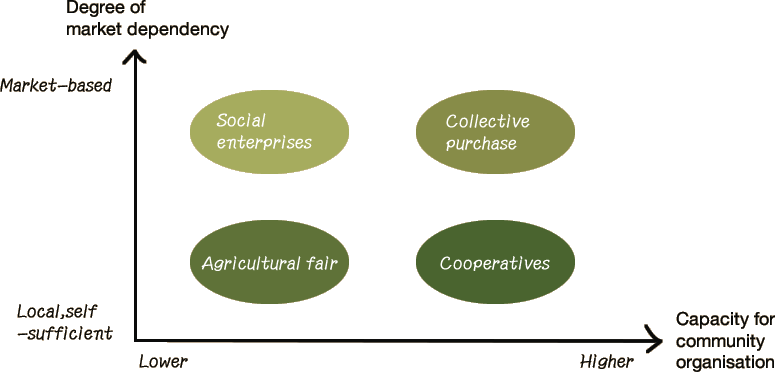
Modes of Community Supported Agriculture
Due to the diversity in agricultural development, in local culture and social class structure, every country or region, while maintaining the spirit of Community Supported Agriculture (CSA), has developed its own form of CSA based on unique local conditions. No matter what form it takes, however, the core spirit of CSA is to build a fair agricultural economic system that focuses on local production and shared commitment that responds to local needs.
From a survey of various forms of CSA, the following were found to be most popular. The degree of their market dependency and their capacity in terms of community organisation are shown in the following diagram:

1.Agricultural Fair /Farmers' Market
The Marketplace/Fair (what the Cantonese called hui) is an embodiment of the culture of collective life for human beings. It is like a heart that connects cities, townships and natural villages. The development of agriculture has resulted in human beings residing together in larger numbers and with greater specialisation, calling for increased exchange of goods. That is why the marketplace first appeared, before permanent towns existed. The marketplace in a rural area plays an important role in the self-sufficiency of the people. It also fosters interaction, understanding, mutual help and exchange between people. In the development of organic agriculture, local organic agricultural fairs/farmers’ markets have enabled direct interaction between organic farmers and consumers, and the building of trust between them.
More information in:"Healthy Soil", Issue No. 3
2.Collective Purchase
Collective purchase means consumers in the community join together to buy healthy products directly from the farmers. This implies the elimination of most processes in between. "Community" may here mean people living in the same area – such as an urban community or natural village; or a group of people working in the same place or organisation; or a group with another common bond such as a farmer cooperative, a consumer cooperative, or even a family. In any case it is a concept of "grouping together". That's why we use the term "collective purchase" to describe any grouping’s direct purchase of products from another grouping. It is similar to what people used to call jicai but is a more sustained kind of activity. The appearance of collective purchase today shows that consumers are more actively concerned with the source and the quality of goods and are networking to buy fair and high-quality goods.
More information:"The Teikei System in Japan"
3.Social Enterprise
A social enterprise is a form of CSA which has become popular only in recent years. The concept comes from the United Kingdom. Though up to now there is no final consensus on the definition of the term, social enterprises are usually engaged in ventures for public benefit. The core idea is that social enterprises make use of the market mechanism to mobilise social forces with a goal of addressing and tackling social problems. In recent years, some CSA initiatives have transformed and become social enterprises that employ staff in various places to encourage farmers and to educate community members in organic farming or ecologically-responsible farming. An organisation called Food Connect in Australia is one of the few social enterprises able to compete with supermarkets.
More information on:http://www.foodconnect.com.au
4.Cooperatives
A cooperative (or co-op) is an association formed voluntarily by people to meet their common economic, social and cultural need. Members of a cooperative practise self-government through communal ownership of property and democratic management. In the development of CSA, farmers' production co-ops and consumers’ co-ops have been formed to build a platform for fair exchange. In 2007, regulations on farmers' production cooperatives were enacted in China and provided impetus for the development of farmers'co-ops in the country.







